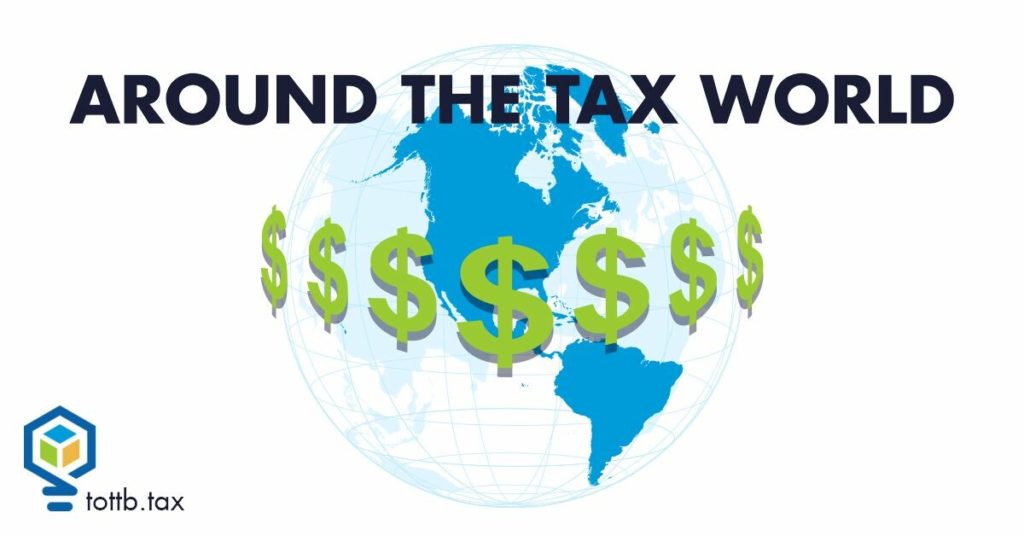
At Around the Tax World, you can find out all about what’s going on in the wonderful, worldwide world of tax. Every month, we’ll feature a few mini-articles on what’s been going on in the world when it comes to tax, and fully available for viewing even if you don’t have a subscription.
If you wish to subscribe and gain access to all articles on the site, be sure to check out the benefits of doing so here!
Check out what’s happening all around the world of tax!
In The Headlines
- Meta will be cutting 5% of its staff in efforts to raise performance standards. This means that the company, which owns Facebook, Instagram, Threads, and WhatsApp, would be laying off around 3,600 workers. In his announcement, CEO Mark Zuckerberg spoke about letting go of “low-performers” and plans to hire replacements. U.S.-based employees are expected to receive updates on February 10th. Meta had already made the news in recent weeks when the company ended its third-party fact-checking program and eliminated its diversity, equity, and inclusion programs. Hundreds of social media users have begun boycotting Meta’s platforms in response to these announcements.
- Will the TikTok drama result in a $50 billion payout or an end to the app as we know it? As social media enthusiasts watched the fluctuating updates on the future of TikTok’s U.S. operations, analysts dug into how much parent company ByteDance could profit from a sale. Estimates suggest that the U.S. portion of the business alone is worth between $40 and $50 billion. On the list of potential buyers are Elon Musk, billionaire Frank McCourt, and Shark Tank personality Kevin O’Leary. The latter has been quoted as saying he’d be willing to pay up to $20 billion for TikTok. The outstanding question is: given the national security issues surrounding the app, will TikTok be profitable in the future, or will another app rise to take its place?
- Capital One is accused of withholding $2 billion in interest from its customers. The Consumer Finance Protection Bureau (CFPB) recently filed a lawsuit against the bank, stating that the company intentionally misled customers by offering two savings accounts with similar names. Capital One marketed its 360 Savings account as having one of the nation’s “highest” interest rates at 0.30% while its newer offering, the 360 Performance Savings account, had interest rates of up to 4.35%. The CFPB claims that the bank intentionally avoided marketing the higher-yield account to existing customers. Additionally, the lawsuit notes that Capital One kept its interest rates low for several years even though rates were on the rise nationally. If the CFPB wins, the bank would have to pay civil penalties to affected customers.
What's New In The Tax World?
What tax changes are Americans most likely to see in the early months of the Trump administration? As the presidency shifts and new legislation begins to surface, taxes are top-of-mind for many. A major platform for Republicans lawmakers has been passing an extension of the Tax Cuts and Jobs Act (TCJA) provisions set to expire after 2025. The measures in question include maintaining lower income tax brackets, a higher child tax credit, and a 20% tax deduction for pass-through businesses. While advocates of these tax provisions are pushing for their renewal as soon as possible, opponents on both sides of the political aisle have summarized their concerns in three words: the federal deficit.
As of 2025, the national debt has risen past the $36 trillion mark, due in part to the rising costs of financing and the decline in tax collections. A recent report showed that the deficit was 40% higher at the end of the last fiscal quarter (October through December) than it was at the same time the previous year. In December 2024 alone, the shortfall for the federal budget landed at $86.7 billion. Estimates by the U.S. Treasury suggest that fully renewing the TCJA tax cuts could cost as much as $4.2 trillion over the next 10 years.
Democratic legislators have also objected that many of these tax cuts disproportionately benefit the wealthiest Americans. The recent Treasury report also found that while TCJA provisions would save the average household 2.2% of after-tax income, the top 0.1% income-earners would save 4.2% in taxes.
One provision that may benefit from bipartisan support is the child tax credit. Under TCJA, the credit available per child was increased from a maximum of $1,000 to $2,000. The current tax law also expanded eligibility for the credit by raising the income limits before the credit begins to phase out. Though TCJA offers a higher maximum credit, the act also capped the refundable portion of the credit, which means that low-income families who owe no tax or a small sum in taxes cannot benefit from the full credit amount. Tax packages featuring a renewed and expanded child tax credit appeared before Congress in 2024, but ultimately Republicans and Democrats were not able to agree on a specific policy.
State-By-State Updates
- Could Arkansas soon say farewell to its grocery tax? Governor Sarah Huckabee made tax cuts a key part of her platform, leading to her election in 2023. Among her initiatives is a plan to cut the 0.125% state grocery tax, limit SNAP benefits to healthy foods only, introducing incentives for schools to buy food from local farmers, and funneling revenue from medical marijuana sales toward the summer EBT program and free school meals. At the same time, state legislators are weighing a new bill that would change the criteria for taxing used cars and add a tax on motorboats. If the bill passes, a 2.875% sales tax would apply to any used vehicles sold for more than $10,000 but less than $15,000.
- Maryland’s governor proposes tax cuts that would impact 82% of residents. The latest budget proposal from Governor Wes Moore would increase income tax rates for those earning $500,000 or more but decrease taxes for everyone else. The state is currently facing a $2.95 billion budget shortfall, but the plan would offset a portion of that by introducing $2 billion in spending cuts and launching a new government efficiency initiative tasked with saving $50 million by identifying waste. Governor Moore’s plan would also eliminate inheritance taxes, cap sales tax increases, and reduce corporate tax rates by 0.25%. As a counterbalance, the proposal would increase taxes on sports wagering, table games, and cannabis and introduce a 1% surcharge on capital gains for households earning over $350,000.
- Utah lawmakers are gearing up for another round of tax cuts in 2025. For the past four years, Utah’s legislators have introduced tax cuts totaling over $1.2 billion. A key part of this has been slowly reducing reliance on the state income tax with the ultimate goal of eliminating the tax completely. Another proposal on the table would repeal the state’s Social Security income tax. Amid the slew of recent tax reductions, Governor Spencer Cox has issued a warning that continuing gradual tax cuts may not be the long-term solution the state needs. Instead, the governor has echoed the call for lawmakers to initiate full tax reform. One concern with the trend of income tax cuts is that the state will have to increase a different tax, such as property taxes or general sales taxes, that could prove even more burdensome for taxpayers.
- Wisconsin celebrates its lowest tax burden in over 100 years. The tax burden is equal to the ratio of how much residents pay in taxes versus how much income they receive. In 2024, the ratio fell from 9.92% to 9.62%, according to the Wisconsin Policy Forum. That percentage has been on the decline since 1970. Last year, the combination of overall income growth and efforts to curb state property taxes dropped the tax burden to a record low. Meanwhile, sales taxes lagged in Wisconsin, marking the slowest year-over-year growth the state has seen since 2010. Sales tax comprised the largest portion of state revenue at 22.4%, which is the highest number on record, followed by income tax and corporate tax.
Tax Planning Tips
A new year’s resolution: Stay on top of your taxes in 2025. Based on the latest from the IRS, 2025 will mean higher federal tax brackets and a higher standard deduction in response to inflation. The standard deduction has been set at $15,000 for single taxpayers and $30,000 for married couples filing jointly.
Changes have also been made to the thresholds for long-term capital gains taxes, the estate tax exemption, and the earned income tax credit. In 2025, single filers earning up to $48,530 in taxable income will not have to pay taxes on long-term capital gains. The same is true for married couples earning up to $96,700. Single filers earning up to $533,400 and married couples earning up to $600,050 will pay a 15% tax.
Additionally, the estate and gift tax exemption will be increased to $13.99 million. Finally, in 2025, the maximum earned income tax credit available will be set at $8,046 for qualifying taxpayers with three or more eligible children, $7,152 for taxpayers with two children, $4,328 for taxpayers with one child, and $649 for taxpayers with no qualifying children.
Private universities may see a higher tax bill if a new legislation makes it through Congress. The 2017 Tax Cuts and Jobs Acts introduced a 1.4% tax for private universities on interest earned through endowments. Endowments are established when a donor gives money or other financial assets to a university and specifies that the gift must be invested and maintained. By preventing the full sum from being spent, the gift is intended to provide ongoing funding for a specific purpose, such as professorships, scholarships, and fellowships.
A new bill called the Endowment Tax Fairness Act would dramatically increase the taxes on endowment profits to the corporate tax rate, which is currently set at 21%. The revenue would be channeled toward reducing the national deficit. Under the terms of this bill, the increased tax would apply to colleges and universities with at least 500 students that maintain assets equal to $500,000 or more per student. The schools that would be most significantly impacted include Columbia, Harvard, Princeton, and Yale, which together manage $270 billion in assets.
NOT A MEMBER YET?

SUBSCRIBE TO GET ALL OF OUR
GREAT ARTICLES AND RESOURCES!
CURRENT EDITION

Qualified Opportunity Zones After the One Big Beautiful Bill Act: What’s Changed and What It Means for Real Estate Investors
On July 4, 2025, the One Big Beautiful Bill Act (OBBBA) became law, representing the most significant reform of the QOZ program since its inception. It made the program permanent, tightened eligibility rules, introduced a rural-focused investment vehicle, and imposed robust reporting requirements. For tax professionals and investors, understanding these changes isn’t just about compliance – it’s also about strategy.

Vibe Preparing: Ignoring Partnership Agreement Impacts on K1s
Nothing derails a busy season schedule like being forwarded emails from client’s investors asking “are you sure the loss is allocated correctly?” It can expose a weakness in technical expertise – especially when it’s a partnership K1. Whether the operating agreement includes Safe Harbor or Target Capital allocations is one of the most important places to start for a preparer. And knowing these basics can be the difference between a confident reply or a lost week.

Deducting Gambling Losses: Part 2: Sessions Method
Recently I polled my peers on a social media platform dedicated to tax professionals. My hope was to find a resource for tax rules on a state level for handling gambling sessions. I knew it would be an uphill battle to get the information needed for a comprehensive guide state-by-state.
What surprised me was the response. A large percentage of tax professionals were either unaware of gambling sessions or were unclear on how gambling sessions were handled in their state. Since gambling sessions might be the best way to reduce taxes on gambling wins, a lot of money might be left on the table with clients paying the price. Even if the state a tax professional prepares most tax returns for does not have gambling, the likelihood a client travels to a state that does, gambles, and wins is high.

